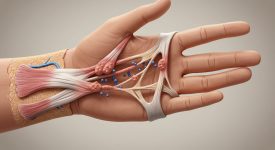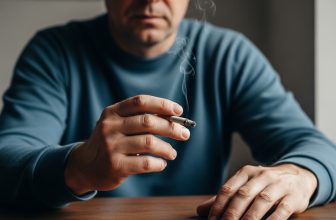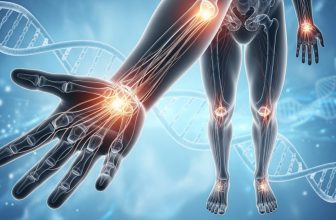
Dupuytren’s Disease Recurrence
Dupuytren’s Disease Recurrence: 7 Key Reasons Your Cords May Return and How to Stop Them
Introduction for
For many patients, the biggest frustration after treatment for Dupuytren’s disease is watching the cords return. Recurrence doesn’t signal failure—it reflects the underlying biology of Dupuytren’s. Understanding why the disease comes back empowers patients to take proactive steps, build a long-term prevention plan, and preserve hand function.
Why Dupuytren’s Returns
Dupuytren’s disease is driven by hyperactive fibroblasts. Even after cords are removed surgically or dissolved with collagenase injections, residual fibroblasts continue to produce collagen. If systemic inflammation, stress, or metabolic imbalances persist, these cells reignite the fibrotic process, creating new cords.
Recurrence rates vary widely, ranging from 20% to 60%, depending on the procedure and disease stage. Needle aponeurotomy offers rapid recovery but carries a slightly higher risk of recurrence than a formal fasciectomy, which removes more diseased tissue.
5 Major Risk Factors for Recurrence
Certain factors significantly increase the likelihood of Dupuytren’s returning:
-
Early-Onset Disease: Patients developing Dupuytren’s before age 50 face more aggressive disease patterns.
-
Family History or Ledderhose Disease: Genetic predisposition plays a central role.
-
Lifestyle Factors: Smoking, alcohol use, and uncontrolled diabetes accelerate fibrosis.
-
Chronic Inflammation: Persistent inflammation and insulin resistance fuel ongoing collagen overproduction.
-
Incomplete Cord Removal: Even small residual nodules can trigger recurrence.
(See also → Ledderhose Disease and Dupuytren’s and Nutrition and Diet in Dupuytren’s.)
How Inflammation and Scar Tissue Contribute
Healing inflammation is a double-edged sword. While necessary for tissue repair, excessive inflammatory response stimulates fibroblasts to overproduce collagen. Myofibroblasts tighten the fascia again, drawing fingers toward the palm. This is why hand therapy, stretching, and early mobilization are essential after any procedure.
Scientific research confirms these mechanisms. Studies from the Mayo Clinic and NIH link oxidative stress and mitochondrial dysfunction to faster recurrence. In other words, cellular energy deficits and chronic stress in the tissue environment make it easier for Dupuytren’s to reemerge.
Proven Treatment Options After Recurrence
Even if cords return, several effective strategies exist to regain hand function:
-
Repeat Needle Aponeurotomy or Collagenase Injections: Effective for mild or early cords.
-
Surgical Revision (Fasciectomy): Recommended for severe or functional-limiting recurrences.
-
Radiation Therapy: Low-dose X-rays calm early fibrotic nodules and slow disease progression.
-
Occupational Therapy & Splinting: Maintain motion and prevent stiffness.
-
Lifestyle Intervention: Anti-inflammatory diet, glucose control, regular exercise, and stress management reduce recurrence risk.
What the Research Shows
A 2019 study in the Journal of Hand Surgery demonstrated that patients who actively managed inflammation and metabolic health experienced significantly slower recurrence rates. Researchers emphasized a “whole-person management” approach, highlighting that isolated surgical correction alone is rarely enough for lasting results.
7 Powerful Takeaways for Patients
-
Recurrence reflects disease biology, not surgical failure.
-
Hyperactive fibroblasts and collagen overproduction drive new cord formation.
-
Inflammation, genetics, and lifestyle are critical triggers.
-
Early-onset patients require more vigilant monitoring.
-
Hand therapy and stretching significantly reduce risk.
-
Lifestyle interventions—diet, exercise, glucose control—support lasting outcomes.
-
Prompt detection of small nodules can prevent secondary surgery.
Long-Term Strategy to Stop Recurrence
Prevention of Dupuytren’s recurrence demands consistent, proactive care. Maintaining balanced collagen production, staying physically active, and reducing chronic inflammation are key pillars. Regular check-ups with a hand therapist or specialist allow for early intervention, often stopping small nodules before they progress into functional limitations.
By adopting a whole-body approach, patients not only improve hand function but also strengthen overall connective tissue health. Combining therapy, nutrition, and lifestyle optimization gives the best chance for long-term success.
Conclusion
Dupuytren’s recurrence is common but manageable. Understanding the biological triggers, knowing your personal risk factors, and implementing a comprehensive plan of therapy, lifestyle changes, and early detection empowers patients to stay ahead of the disease. With vigilance and consistent care, the cords can be controlled—and hand function preserved for years to come.
If you’re living with diabetes, learn how to protect your hands. Visit https://www.dupuytrensolutions.com and join our support network at https://www.facebook.com/groups/dupuytrensolutionsandhealth.






